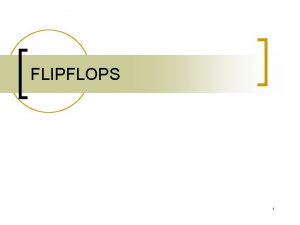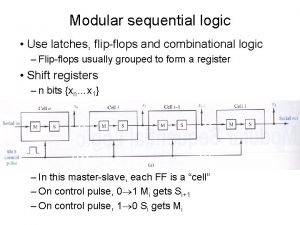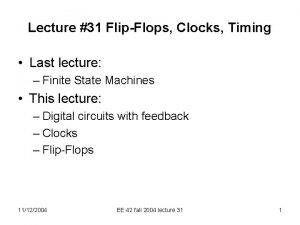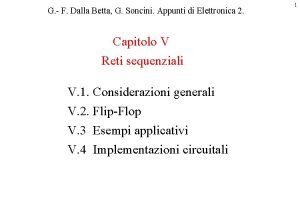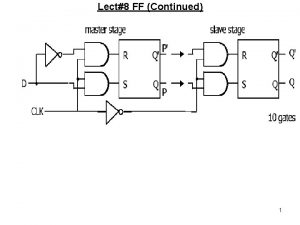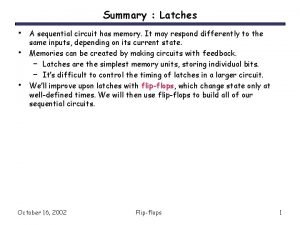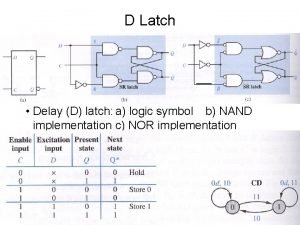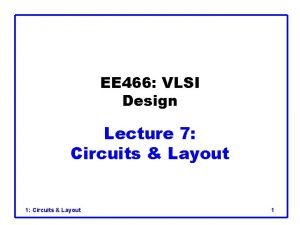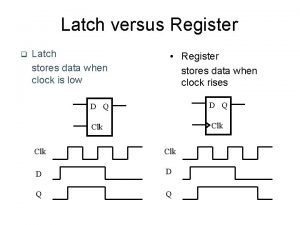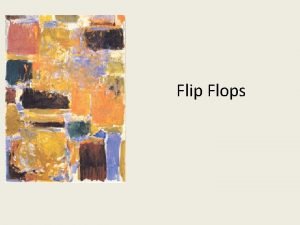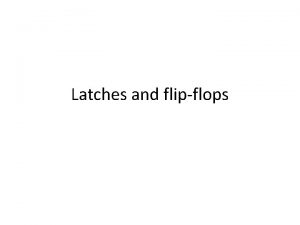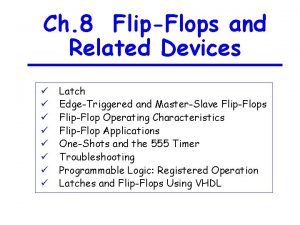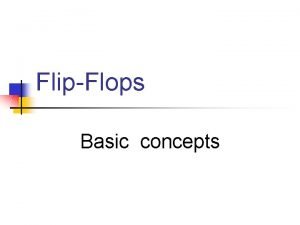FLIPFLOPS 1 SR latch n Crosscoupled NOR gates
















- Slides: 16

FLIPFLOPS 1

SR latch n Cross-coupled NOR gates ¡ R S Can set (S=1, R=0) or reset (R=1, S=0) the output Q Q' Reset R Q Set S Q S 0 0 1 1 R 0 1 Q hold 0 1 disallow 2

SR latch behavior R Q S Q' Reset Hold Set S 0 0 1 1 R 0 1 Q hold 0 1 disallow Reset Set 100 Race R S Q Q' 3

SR latch is glitch sensitive n Static 0 glitches can set/reset latch ¡ ¡ 0 0 Glitch on S input sets latch Glitch on R input resets latch R Q S Q' 4

State diagrams n How do we characterize logic circuits? ¡ ¡ n First draw the states ¡ n Combinational circuits: Truth tables Sequential circuits: State diagrams States Unique circuit configurations Second draw the transitions between states ¡ Transitions Changes in state caused by inputs 5

Example: SR latch SR=10 R Q Q Q' 0 1 Q' S S 0 0 1 1 SR=00 SR=01 R 0 1 Q hold 0 1 disallow Q Q' 1 0 SR=10 SR=01 SR=11 SR=01 possible oscillation between states 00 and 11 (when SR=00) Q Q' 0 0 SR=00 SR=11 SR=10 SR=00 Q Q' 1 1 6

Observed SR latch behavior n The 1– 1 state is transitory ¡ ¡ ¡ Either R or S “gets ahead” Latch settles to 0– 1 or 1– 0 state ambiguously Race condition non-deterministic transition n Disallow (R, S) = (1, 1) SR=10 SR=01 Q Q' 0 1 Q Q' 1 0 SR=00 SR=10 SR=01 7

D ("data") latch n Output depends on clock ¡ ¡ Input Clock high: Input passes to output Clock low: Latch holds its output D Q Q CLK D Qlatch 8

Making a D latch D CLK D R Q S Q 9

D flip-flop n Input sampled at clock edge ¡ ¡ n Input Rising edge: Input passes to output Otherwise: Flip-flop holds its output D Q Q CLK Flip-flops can be rising-edge triggered or falling-edge triggered CLK D Qff 10

Master-slave D-type flip-flop Master D latch Input D Q X Slave D latch D Q Output CLK n How to make into negative edgetriggered D-type flip-flop? 11

Latches versus flip-flops D Q CLK Q D CLK D Q Q CLK Qff Qlatch behavior is the same unless input changes while the clock is high 12

Terminology and notation Rising-edge triggered D flip-flop Input D Q Output Positive D latch Input D Q Output CLK Falling-edge triggered D flip-flop Negative D latch Input D CLK Q Output 13

How to make a D flip-flop? n Edge triggering is difficult ¡ ¡ ¡ Label the internal nodes Draw a timing diagram Start with Clk=1 W X Q Clk Q’ Y D Z 14

How to make a D flip flop? Falling edge-triggered flip-flop If Clk=1 then X=Y=0 and SR latch block holds previous values of Q, Q’, also Z=D’ and W=Z’=D. W X Q When Clk 0 then Y (set for SR latch block) becomes Z’=D and X (reset for SR latch Clk block) becomes W’=D’ so Q becomes D. Q’ Y While Clk=0, if D switches then Z becomes 0 (because inputs to Z are D and D') and X and D W hold their previous values and Y=X’=D as before. Z 15

T ("toggle") flip-flop n Output toggles when input is asserted ¡ ¡ If T=1, then Q Q' when CLK If T=0, then Q Q when CLK Input T Q > CLK Q Input(t) 0 0 1 1 Q(t) 0 1 Q(t + t) 0 1 1 0 16
 Sr latch with nor gates
Sr latch with nor gates Angareion
Angareion Shallow latch vs deep latch
Shallow latch vs deep latch Flipflops
Flipflops Flipflops
Flipflops Gated d-latch
Gated d-latch Nor death nor principalities
Nor death nor principalities Nor death nor principalities
Nor death nor principalities Nor death nor principalities
Nor death nor principalities Latch sr
Latch sr Sr flip flop characteristic equation
Sr flip flop characteristic equation Latch timing problem
Latch timing problem Pn flip flop
Pn flip flop Latch devresi
Latch devresi Latch delay
Latch delay And table truth
And table truth D latch stick diagram
D latch stick diagram
